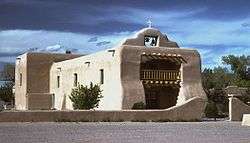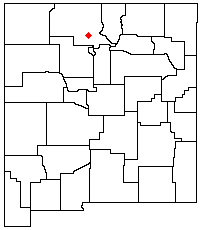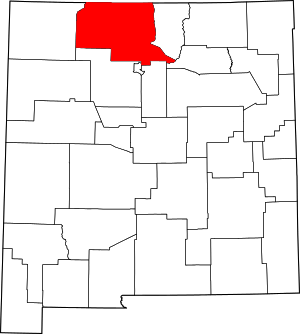Abiquiú, New Mexico
Abiquiú (or Abiquiu[2] /ˈæbɪkjuː/ (![]()
Abiquiú, New Mexico | |
|---|---|
 The adobe Santo Tomás Church in Abiquiú | |
 Location of Abiquiú within New Mexico | |
 Abiquiú, New Mexico Location in the United States | |
| Coordinates: 36°12′34″N 106°19′7″W | |
| Country | United States |
| State | New Mexico |
| County | Rio Arriba |
| Area | |
| • Total | 1.0 sq mi (3 km2) |
| • Land | 1.0 sq mi (3 km2) |
| • Water | 0.0 sq mi (0 km2) |
| Elevation | 6,080 ft (1,853 m) |
| Population | |
| • Total | 231 |
| • Density | 230/sq mi (89/km2) |
| Time zone | UTC-7 (Mountain (MST)) |
| • Summer (DST) | UTC-6 (MDT) |
| ZIP code | 87510 |

Abiquiú means "wild choke cherry place" in the Tewa language. The community is also called Santo Tomás de Abiquiú and the Pueblo of Santo Tomás de Abiquiú.[3] Abiquiú was one of the homes of artist Georgia O'Keeffe from 1929 until 1984. The Georgia O'Keeffe Home and Studio is in Abiquiú and she also owned property at the nearby Ghost Ranch. Many of her paintings depict scenes near Abiquiú.
History
Abiquiú was first settled in 1742 by 24 Tewa Pueblo families led by a Roman Catholic priest, Francisco Delgado. The Tewa returned to New Mexico after a lengthy residence among the Hopi people in what would become Arizona. Their settlement in Abiquiú was part of the strategy by New Mexico to defend its frontiers against marauding American Indians such as the Apache, Comanche, and Navajo. Abiquiú was on the northern border of the Spanish settlements of New Mexico.[4] In 1747, in one of the numerous Indian raids in the area, Comanches took 23 women and children captive, forcing the temporary abandonment of Abiquiú. The captives probably became part of the flourishing slave trade between and among the Spanish and the surrounding Indian tribes.[5]
In 1754, to deal with the Indian raids and the faltering settlement, New Mexico governor Tomás Vélez Cachupín gave 34 Genízaro families a land grant in exchange for them taking a prominent role in frontier defense. Abiquiú was the third Genízaro settlement established in New Mexico, after Belen and Trampas. The Genízaros were American Indians of various tribes whose origin was as slaves, captives, and servants of the Spanish. With few rights under the casta laws of the Spanish, resettlement on the dangerous frontier of New Mexico was the principal way for Genízaros to become landowners. Abiquiú became the archetypal Genízaro settlement with residents still celebrating their Genízaro heritage in the 21st century.[6]
In the late 18th century, peace was established between New Mexico and the Comanche and Utes. An annual trade fair at Abiquiú drew many Indians to the town, especially the Utes who traded deer skins for horses and tools. Also, captive children were purchased or redeemed from the Indians. Bands of Utes often camped for the winter near Abiquiú. However, in the 1840s, the peace with the Utes broke down and 1,000 of them came to Abiquiú with a list of grievances and demands. Subsequently, several Utes were killed. Peace with the Utes was restored in 1849 by the United States government, which had recently invaded and conquered New Mexico in the Mexican–American War.[7]
Throughout the 19th century, the residents of Abiquiú struggled to retain ownership of the 16,000 acres (6,500 ha) of land provided them by the 1754 land grant. In 1894, the rights of the community to the land was validated in the Court of Private Land Claims. In 1969, additional land, previously designated as National Forest, was returned to the community. Abiquiú is a popular tourist destination, and some Anglo-Americans have settled in the community.[8]
The Old Spanish Trail
Abiquiú was the starting point of the pioneering route of the Old Spanish Trail. This first route, the Armijo Route, was led by Antonio Armijo of Santa Fe, with sixty mounted men and a caravan of pack animals carrying blankets and other trade goods to barter for mules in Alta California. Armijo's caravan left San Gabriel Mission on November 6, 1829 and made the journey to Abiquiú in eighty-six days, arriving on January 31, 1830. He returned by the same route in 56 days, leaving March 1 and arriving back on April 25, 1830. Unlike the other routes of the Old Spanish Trail, Armijo's route was documented day by day by him, although in a very brief report listing dates and stopping places with few details and no distances recorded. It was submitted to the governor José Antonio Cháves and published by the Mexican government on June 19, 1830.[9]
In popular culture

The colorful canyons and mountains near Abiquiú have been featured in numerous movies, including Red Dawn (1984), Silverado (1985), Lonesome Dove (1989), City Slickers (1991), The Last Outlaw (1993),[10] Wyatt Earp (1994), The Wild Wild West (1999), All the Pretty Horses (2000), The Missing (2003), 3:10 to Yuma (2007), No Country For Old Men (2007), Indiana Jones and the Kingdom of the Crystal Skull (2008), Cowboys & Aliens (2011) and The Lone Ranger (2013),[11] and in the TV series Earth 2.[12]
"Abiquiu" is the title of an episode of Breaking Bad. During the episode, a flashback shows Jesse Pinkman and Jane Margolis visiting a Georgia O'Keefe exhibition, presumably the one in Abiquiú.
Nearby points of interest
| Wikivoyage has a travel guide for Abiquiu. |
- Abiquiu Lake
- Dar al-Islam (organization)
- Echo Amphitheater
- Georgia O'Keeffe Home and Studio
- Ghost Ranch, home of the Ruth Hall Museum of Paleontology
- Monastery of Christ in the Desert
- Santa Rosa de Lima, New Mexico, a ghost town
Notable people
- Julian A. Chavez (1808–1879), rancher, landowner and elected official in Los Angeles, California
- Georgia O'Keeffe American Artist.
References
- "2010 Census Gazetteer Files - Places: New Mexico". U.S. Census Bureau. Retrieved October 20, 2017.
- U.S. Geological Survey Geographic Names Information System: Abiquiu
- Gonzales, Moises (Winter 2014), "The Genizaro Land Grant Settlements of New Mexico," Journal of the Southwest, Vol. 56, No.4, pp. 588-592
- Gonzales, pp. 583, 588–589
- Brooks, James F., Captives and Cousins: Slavery, Kinship, and Community in the Southwest Borderlands, Chapel Hill: University of North Carolina Press, p. 68
- Gonzales, pp. 588–591
- "Pueblo de Abiquiú--a Genizaro Community," New Mexico History, , accessed 25 Feb 2019
- "Pueblo de Abiquiú – A Genízaro Community – New Mexico History.org". Retrieved 2019-11-09.
- LeRoy R. Hafen and Antonio Armijo, Armijo's Journal,Huntington Library Quarterly, Vol. 11, No. 1 (Nov., 1947), pp. 87-101, Published by: University of California Press,DOI: 10.2307/3816035
- "The Last Outlaw (TV 1993)". IMDb. Retrieved 7 June 2011.
- Maddrey, Joseph (2016). The Quick, the Dead and the Revived: The Many Lives of the Western Film. McFarland. Page 182. ISBN 9781476625492.
- "On the Set : Weathering 'Earth 2'".
